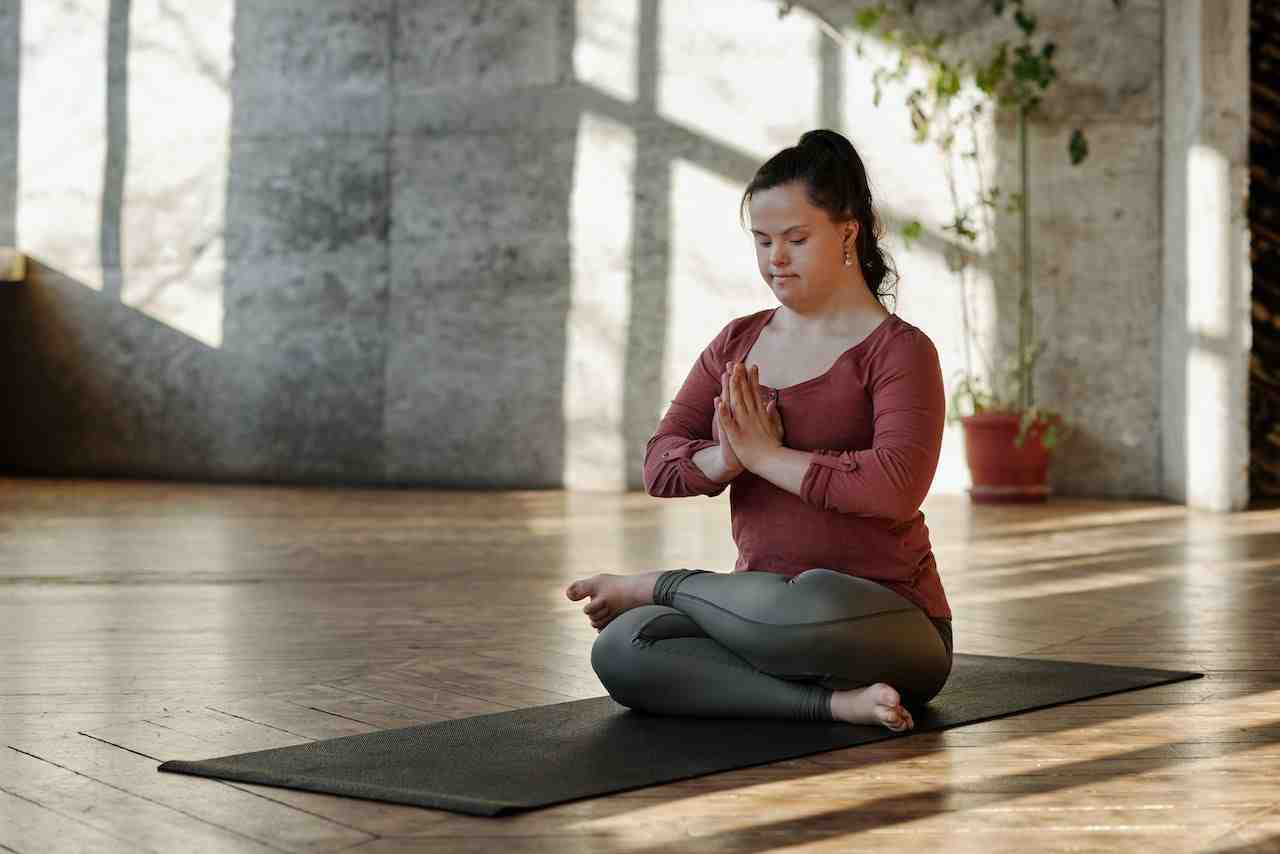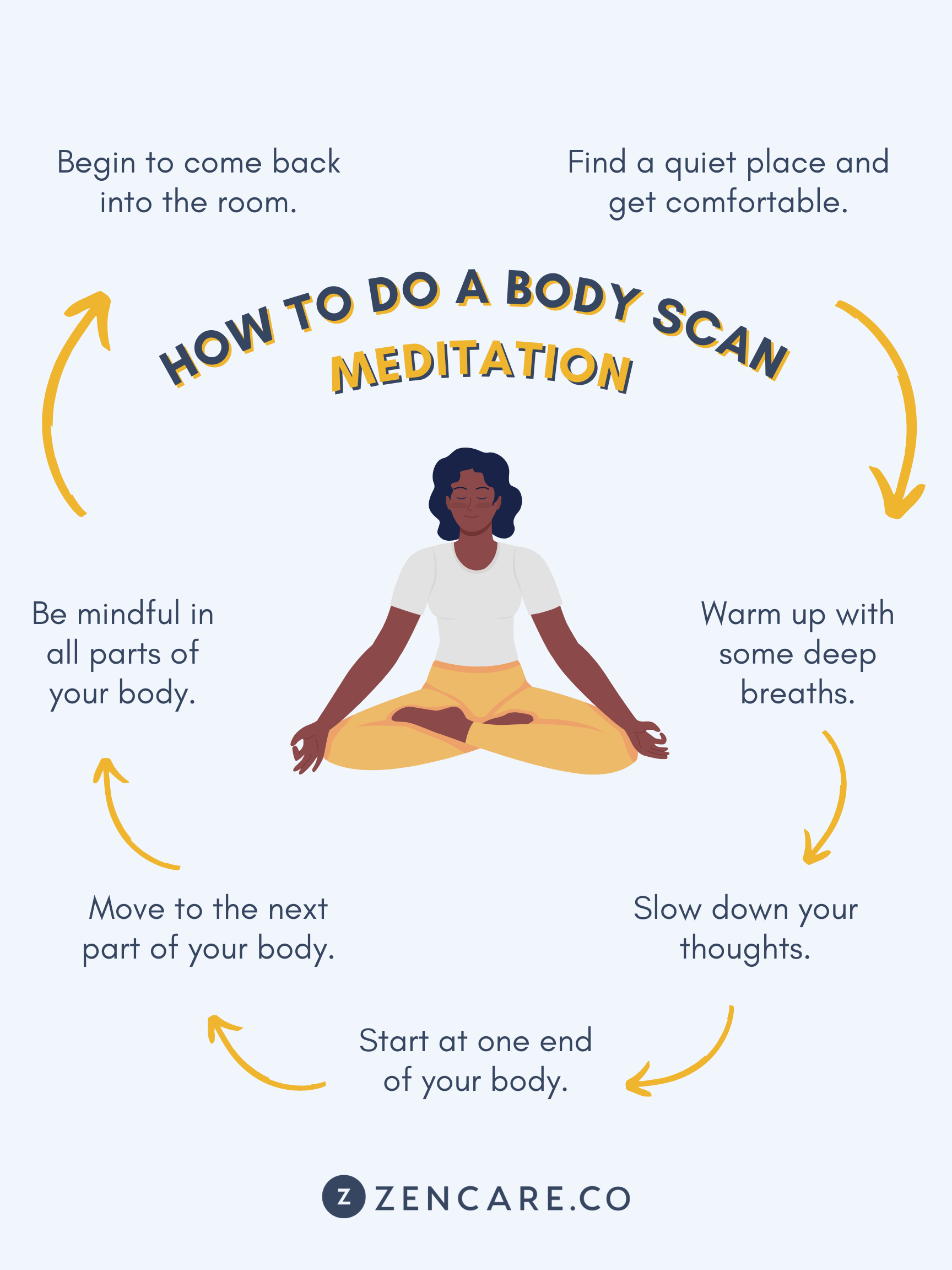Have you ever gone through your whole day only to realize that you’ve been tensing your facial muscles this whole time? Do you notice at work that your shoulders are up near your ears, and have been for hours? Our minds and our bodies are undoubtedly linked, and our stress shows up in our muscles, nerves, tendons, and more.
Body scanning is a mindfulness technique that focuses on relieving our physical experiences of stress. When implemented as a regular targeted meditation practice, body scanning can help you improve your sleep, manage your anxiety levels, and reduce physical discomfort.

What is mindfulness?
Mindfulness describes any intentional practice of shifting your awareness internally. Our brains and bodies go on autopilot throughout the day, so most of our thoughts and sensations go unnoticed or unacknowledged. When we shift our focus to what’s happening in our minds and in our bodies, we can begin to slow down, which can offer relief from unhelpful or negative thoughts.
For example, what are you thinking about right now? You might notice that while you’re reading this sentence, you’re also thinking about your next assignment’s due date. You might be feeling frustrated with a friend and ruminating on their latest text. It can seem complex to “think about your thoughts,” but mindfulness is a way to increase your self-awareness of what you’re internally experiencing and create space between what’s happening and how you’re presently experiencing it. When practicing mindfulness, you’re centering yourself in the present rather than the past or the future.
Meditating is one mindfulness technique, but there are many other ways to practice mindfulness. You might even be surprised at some of the activities that can become mindfulness exercises, including mindful walking, mindful eating, or mindful cleaning. Even one deep breath can be a mindfulness exercise! Any activity where you can purposefully examine how you’re feeling — what thoughts are coming into your mind and what sensations you’re experiencing — and start to reduce those thoughts and feelings can be a mindfulness exercise.
What is body scanning?
Body scanning is a mindfulness practice that systematically shifts your attention throughout your body, from head to toe.
In a body scan, you’ll draw attention to all parts of your body, all while slowing down your thoughts and engaging in deep breathing. The aim is to check in with yourself, relax any tension in your body, and exist in the moment by acknowledging and then letting go of the thoughts coming across your mind. You can do this in any setting, whether you’re at home, sitting at your desk at work, or while standing on the bus. It’s a useful, accessible mindfulness practice that many beginners pick up as they progress along their mindfulness journey.
How to do a body scan meditation
Because body scan meditations rely on easy-to-follow instructions and have a logical flow, they’re one of the most widely-used mindfulness practices. To complete a body scan meditation, follow these steps:
- Find a quiet place and get comfortable. Body scan meditations are best done when there aren’t noise or visual distractions. Find a quiet space where you feel comfortable shutting your eyes. If you’re at home, you can lie in bed or find a comfortable position lying on your floor. You can also complete a body scan meditation in a seated position, as long as that’s comfortable for you.
- Warm up with some deep breaths. If you’re new to mindfulness practices, the breath is a good place to start. Take three slow, deep breaths. Feel the air coming into your throat, down into your chest, and spread across your lungs. Try to make each inhale and exhale as slow as possible. If you get lost in this meditation, the breath is always a good place to return to — reset with deep breaths.
- Slow down your thoughts. The goal in mindfulness practices is to exist in the moment. We can arrive at this goal by slowing down our thoughts. It can be helpful to focus on your breathing. If you find that you’re thinking about something, acknowledge the thought and then let it slip away without further consideration. Some people like to visualize a blank chalkboard or an empty space.
- Start at one end of your body. Most people start their body scan at their toes, while others prefer to start at the top of their heads. Focus on how your body feels in that area. Is it tight? Warm? Loose? Without making any judgments, notice the sensations in that part of your body. You might notice the feeling of the ground beneath your body. If you feel tension, try to relax your muscles while continuing to breathe deeply. You might need to clench and then unclench your muscles to achieve relaxation.
- Move to the next part of your body. Very slowly, turn your attention to the next part of your body. If you started with your toes, notice how your feet and ankles feel. After that, move onto your shins and calf muscles. You’ll focus on each part of your body, relaxing into your sensations.
- Be mindful in all parts of your body. Once you’ve drawn your attention across your entire body, from your head to your toes, spend a few moments experiencing your body as a whole. Some people like to visualize a golden light filling their bodies or a warmth spreading into each finger or toe.
- Begin to come back into the room. You can stay in your meditation as long as you would like, but once you’re ready, start to turn your attention to the room around you. You might start by paying attention to what you hear, then slowly opening your eyes. Take another series of deep breaths, focusing on the feeling of air entering and leaving your body, and gently wiggle your body. When you’re ready, end the meditation.
What are the different types of body scan meditations?
Body scan meditations can be tailored to different concerns. Many people will adjust their meditation to help them with their stress, insomnia, anxiety, or chronic pain. Through trial and error, you can find the right pattern and visualizations for a body scan, and the best times for you to practice this meditation.
Most people find that it can be helpful to use a guided meditation for body scanning — so you can seek out a body scan script, whether it's text, audio or video, that targets your condition. You can easily find specific body scan meditations for sleep, meditations for chronic pain, and meditations for anxiety.
Tips for starting with meditation like body scanning
Mindfulness practices like body scanning can be intimidating to start. Here are some tips for starting with meditation through body scanning:
- Don’t judge yourself. Whatever happens while you’re meditating, withhold your self-criticism. The goal of mindfulness is to acknowledge a distraction and then refocus your attention inwards.
- Return to your breath. If you find yourself lost or confused about what you should be doing during your meditation, return to your breath. You might spend several minutes simply breathing before you restart your body scan, and that’s okay.
- Thank your thoughts and then move on. If you keep finding yourself with thoughts floating around your head, it can be helpful to implement a mantra to help you refocus. This could be: “I had a thought. Thank you. Now I’ll move on.” This mantra can be your cue to let go of the thought and to clear your mind once more.
- Your practice is your practice. All brains and bodies are different, so mindfulness practices need individualization. What works for one person might not work for another person. Find what feels best for you!
What are the benefits of body scanning?
Body scanning and other mindfulness practices can lead to reduced anxiety, decreased pain, and improved cognitive functioning like decision-making. When practiced regularly, mindfulness becomes easier as your brain learns how to relax into the present moment.
Body scanning can help you avoid burnout by lowering your stress levels and by giving you a reprieve from your stressors — which, even temporarily, can protect you from emotional exhaustion.
Additionally, maintaining a regular mindfulness practice like body scanning can help you build self-discipline, which can be beneficial in other areas of your life. Having self-discipline can be useful when you’re trying to improve your sleep hygiene, develop healthier eating or exercise behaviors, or implement positive psychology techniques into your daily routines.
Along with its physical benefits, body scanning can also ground you in the current moment. Letting go of your past and future worries — even if just for a few minutes — can give your brain a moment to relax, allowing it a sense of peace. After a mindfulness practice like body scanning, you may feel re-energized, relaxed, and ready to take on what’s next in your day.
How a therapist can help with mindfulness and body scanning
Sometimes mindfulness and body scanning can be difficult to do on your own. Many therapists specialize in mindfulness practices or grounding techniques, and can help you identify ways to improve your practice. With Zencare, you can filter your search to show you therapists who have expertise in mindfulness, meditation, yoga and movement therapy. By finding a therapist to help strengthen your mind-body connection, you can feel comfortable and relaxed, giving you the space to do more of what you love.
